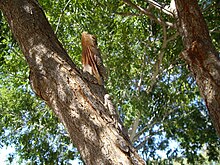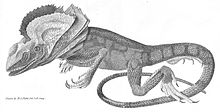Chlamydosaurus kingii
The frilled-necked lizard (Chlamydosaurus kingii), also commonly known as the frilled agama, frilled dragon or frilled lizard, is a species of lizard in the family Agamidae. The species is endemic to northern Australia and southern New Guinea. This species is the only member of the genus Chlamydosaurus.
Its common names come from the large frill around its neck, which usually remains folded up against the lizard's body.
C. kingii is largely arboreal, spending most of its time in trees. Its diet consists mainly of insects and small vertebrates, and, sporadically, also plants.
The frill-necked lizard is a relatively large lizard, averaging 2.79 ft (85 cm) 2.8 ft (85 cm) in total length (including tail), and is kept as an exotic pet.
The frill-necked lizard was also a great inspiration for the dilophosaurus shown in the movie Jurassic Park. And although the movie made them popular, these lizards don't even spit venom, they don't even scream in a similar way to dilophosaurus.
Taxonomy
British zoologist John Edward Gray described the frill-necked lizard in 1825 as Clamydosaurus Kingii, from a specimen collected by an expedition led by Captain Phillip Parker King of HMS Mermaid. The specimen de King was obtained by his ship's botanist, Allan Cunningham, at Careening Bay on the northwest coast of Australia.
The generic name, Chlamydosaurus, is derived from the Ancient Greek chlamydo (χλαμύς), meaning "covert" or "covered", and saurus (sauros), meaning "lizard". The specific name, kingii, is a Latinized form of Phillip Parker King's last name. It is the only member of this genus.
In the Jawoyn language of the Katherine area, it is known as leliyn.
Description
The frill-necked lizard is a relatively large member of the family agamidae, growing to 85 cm (2.79 ft) 85 cm (2.8 ft). It is capable of bipedal locomotion and has been described by naturalists as moves regularly in this manner, with a determined gait at times.
Coloration tends to be brown or gray with blotches and blotches of darker colors mixed in a mottled fashion to give the appearance of tree bark. There is no standard color: rather, coloration varies depending on the lizard's environment. For example, a lizard found in a more desert-like, clay-filled environment will likely have a collage of oranges, reds, and browns; While a lizard found in a lusher, more tropical region, it will tend to display darker browns and grays. This suggests that they are adapted to their habitats; Their colors are a form of camouflage.
The most distinctive feature of these lizards is the large pelt of skin that is usually folded back against their head and neck. The neck frill is supported by long cartilage spines that are connected to the jaw bones. When the lizard is startled, it produces an amazing deimatic display: it opens its mouth, exposing a bright pink or yellow lining; extends frill, showing bright orange and red scales; raise your body; and sometimes holds its tail over its body. This reaction is used for territorial displays, to discourage predators, and during courtship. The red and orange parts of its frill contain carotenoid pigments.
The frill bones are modified, elongated types of hyoid that form rods that expand the frill. Second, the frill can serve as a form of camouflage when relaxed; There is no standard coloration for the body, but it is generally darker than the frill.
Distribution and habitat
The frill-necked lizard is found mainly in the northern regions of Australia and southern New Guinea. The lizard is rarely found in the lower desert regions of Australia, but inhabits mainly humid climates like those of tropical savannah forests.
Tends to be an arboreal lizard, meaning it spends most of its time in trees. The lizard ventures to the ground only to forage for food, or to engage in territorial conflicts. Tree habitat it may be a product of the lizard's diet, which consists mainly of small arthropods and vertebrates (usually smaller lizards). However, trees are most often used for camouflage.
Diet
Like many lizards, frill-necked lizards are carnivorous, feeding on cicadas, beetles, termites, and mice. They especially favor butterflies, moths, and their larvae. Although insects are their main food source They also consume spiders and occasionally other lizards. Like most members of the agamids (dragons), frill-necked lizards employ an ambush method of hunting, lying in wait for their prey. When lizards do eat, they eat in abundance, these binge periods generally occurring within the wet season, when they ingest hundreds of thousands of winged (flying) ants or termites.
Thermoregulation
The frilled-necked lizard is ectothermic and maintains its body temperature by briefly basking in the sun to reach an average of 2-3 °C above ambient temperature. Climatic conditions, including sunlight, are the main factors. factors that regulate the temperature of lizards. This rest period generally occurs from morning to afternoon to ensure maximum exposure to sunlight. However, the final internal temperature of the lizard depends mainly on the ambient temperature of the surrounding environment. The lizard's frill was thought to aid in thermoregulation, but this has been shown not to be the case.
Reproduction and sexual dimorphism
The frill-necked lizard is sexually dimorphic; which means that there are physical differences between males and females. This dimorphism is evident in the length of the lizard, the male being generally larger than the female. There is little or no dimorphism in the lizard's color.
Frilled-necked lizards breed early in the wet season from September to October. Adult males fight their mates, displaying their frills and biting each other. One to two clutches of 6-25 eggs are laid from the rainy season to the middle of the wet season from November to February. Eggs are laid in a nest 5-20 cm below ground, and usually in sunny areas. Incubation takes two to three months. Gender is determined in part by temperature, with extreme temperatures producing exclusively females, and intermediate temperatures (29 to 35°C) producing equal numbers of males and females. Their bones are soft-shelled.
Predators
The main predators of the species are eagles, owls, larger lizards, snakes, dingoes, and quolls.
In culture
A frill-necked lizard appeared on the reverse of the Australian 2 pence coin until 1991. A frill-necked lizard named "Lizzie" it was the mascot of the 2000 Summer Paralympics. The lizard features on the North Australian NORFORCE regiment emblem.
Due to its unique appearance and behavior, the creature has often been used in film and television. A frill-necked lizard named "Frank" appeared in the 1990 Disney animated film The Rescuers Down Under. In the 1993 film Jurassic Park, the dinosaur Dilophosaurus was portrayed with a frilled neck that rose when attacking, and led to increased demand for frilled-necked lizards as pets.
Further reading
- Bedford GS. (1995). "Anti-predator tactics from the Frilled Neck Lizard Chlamydosaurus kingii ". Journal of the Victorian Herpetological Society 6 (3): 120-130.
- Harlow PS, Shine R. (1998). "Temperature dependent sex-determination in the frillneck lizard Chlamydosaurus kingii (Agamidae) Herpetologica 55 (2): 205-212.
- Shine R, Lambeck R. (1989). "Ecology of frillneck lizards, Chlamydosaurus kingii (Agamidae) in tropical Australia." Australian Wildlife Research 16: 491-500.
Contenido relacionado
Gerhard gentzen
Myrmecophagidae
United Nations Industrial Development Organization




